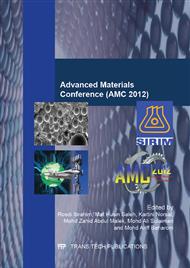p.58
p.63
p.73
p.79
p.85
p.90
p.96
p.102
p.107
Physical and Mechanical Properties of Sintered Titanium Alloy Produced through Metal Injection Molding (MIM) Process for Craniofacial Application
Abstract:
Metal injection molding (MIM) is capable of mass producing intricately shaped components. In recent years, this technology has been adopted in the electronic, computer, aerospace and medical industries. Titanium alloy (Ti6Al4V) is difficult to process because of its reactive nature and primarily because of problems with carbon and oxygen impurities. Even at low concentration, these interstitials can severely degrade the mechanical properties of titanium and its alloys. The main objective of this study is to develop a sintering condition that would eliminate problems with carbon and oxygen contamination and facilitate binder removal, thus enhance the sintering properties. Ti6Al4V with binder formulation consists of polyethylene (PE), paraffin wax (PW), stearic acid (SA) and palm oil derivatives; palm stearin (PS) were mixed homogeneously and injected to produce green compacts. The binders then were removed and sintering of injection molded material was conducted up to 1200 °C in vacuum atmosphere. The parts sintered at 1150 °C for 8 h exhibited among the highest tensile strength of 921.1 MPa while the elongation, density, porosity and hardness was 6.4%, 4.358 g/cm3, 3.16% and 320 HV respectively. This is the advantageous of additional argon flow during debinding , whereas the physical and mechanical properties were improved due to the impurity gas in argon that had strong effects on the aspects of densification and elimination of pores that turn the powder into a dense solid Ti6Al4V.
Info:
Periodical:
Pages:
85-89
Citation:
Online since:
January 2014
Keywords:
Price:
Сopyright:
© 2014 Trans Tech Publications Ltd. All Rights Reserved
Share:
Citation:


